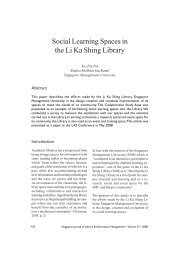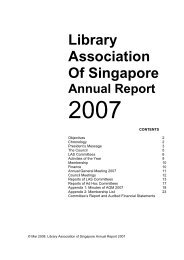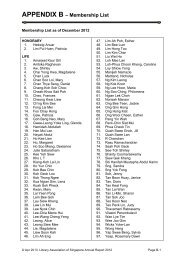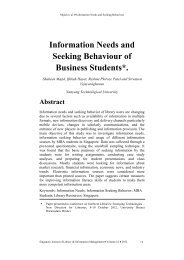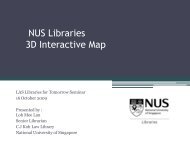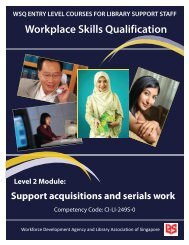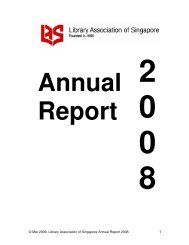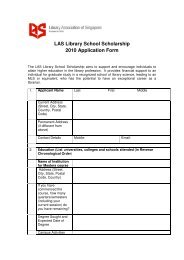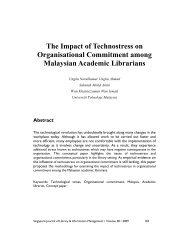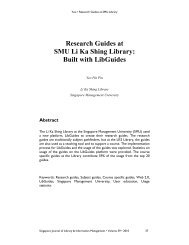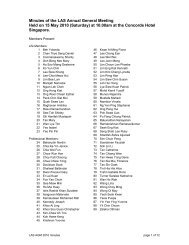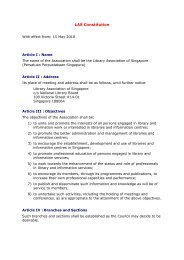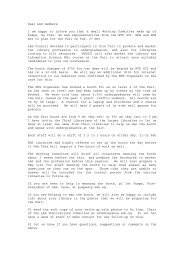Digital Repository @ NTU Joy Wheeler Librarian (Library ...
Digital Repository @ NTU Joy Wheeler Librarian (Library ...
Digital Repository @ NTU Joy Wheeler Librarian (Library ...
You also want an ePaper? Increase the reach of your titles
YUMPU automatically turns print PDFs into web optimized ePapers that Google loves.
The second part of phase 1 involved uploading a pilot community. The AsianMedia Information and Communication (AMIC) collection was selected for our pilotproject, we managed to obtain the copyright clearance to digitize and make thecollection available for open access in the public domain. This is a print collection thatcomprises of 40 titles of conference proceedings. We employed a vendor to digitizeindividual articles of all the proceedings. Each and every article was scanned, saved asa PDF file and then watermarked with a copyright notice. In addition, metadata foreach file was also created. In all over 3,000 items were prepared to be imported intothe new system.Once the files were digitized we hired a student to create the files necessaryfor the records to be ingested into Dspace. Manual creation of the records is a verytime consuming task. This was also another setback as this took a lot more time thanwe anticipated. The following 3 files are needed for batch uploading, [Source file,Content file, Xml file]. The xml file contains all the descriptive metadata following thestandards of Dspace which adopts strict Dublin Core standards for the metadata. Wechose to use a very simple schema for these files. Once the folders and files wereprepared we were able to easily batch upload the files. The greatest difficulty of thisprocess was the time taken to create the xml files and the human errors that arepossible.The AMIC collection was then uploaded and became our first collection in DR-<strong>NTU</strong>. During this first exercise we learned a great deal about the customized importingtool and how we could improve the process for the next phase.Phase 2: Migrating current <strong>NTU</strong> Publications to Dspace (April 2007 – July 2008)In September 2007, the University <strong>Librarian</strong> initiated a working committeeincorporating the project team members, representatives from the Serials Division,6 | <strong>Digital</strong> <strong>Repository</strong> @ <strong>NTU</strong> <strong>Joy</strong> <strong>Wheeler</strong>
Bibliographic Services Division and Humanities and Social Sciences (HSS <strong>Library</strong>) towork on the policy, subject taxonomy, metadata structure, and implementation plans.Migration from <strong>NTU</strong> PublicationsThe bulk of the second phase of the project involved moving the current <strong>NTU</strong>Publications collection, which includes student theses, examination papers, etc., tothe DR-<strong>NTU</strong>. This task included:Coordinating with the CITS on the ITQ specifications to migraterecords from the <strong>NTU</strong> Publications to DR-<strong>NTU</strong>.Finding and working with the vendor to export over 35,000 records forthe migration.Creating a customized semi-automated batch program to import <strong>NTU</strong>Publication records to be migrated to DR-<strong>NTU</strong>.Defining the subject taxonomy for DR-<strong>NTU</strong> and customizing theworkflow and submission process.The first step in this migration was to create a tool that could ease themigration process, as we learnt in the first test collection, it is a very time consumingprocess to create all the xml files needed for each individual record, making itnecessary to find a way to batch upload all the files in a semi automatic way. Toaccomplish this task a new tool was created by Jayan Chirayath Kurian, the Projectofficer at WKWSCI.This tool uses Microsoft Excel spread sheets to store the metadata that isextracted from the RIMS system, it is then run through a programme which generatesthe necessary folders and files required by Dspace [Source file, Content file, Xml file].7 | <strong>Digital</strong> <strong>Repository</strong> @ <strong>NTU</strong> <strong>Joy</strong> <strong>Wheeler</strong>
This semi-automatic ingestion into DR-<strong>NTU</strong> extracts metadata and digital resourcesfrom the excel sheets that are provided by the vendor. After this process, batchingestion into the respective DR-<strong>NTU</strong> collections can be accommodated.The migration was a very time consuming process, but the cleanup of thebibliographic records will take time as well. The earlier system running on MicrosoftSharepoint only allowed very limited metadata to be captured and the records are verybasic. A workflow was set up so that the <strong>NTU</strong> <strong>Library</strong> Bibliographic Services Divisioncould help with the editing of the migrated records. They were also asked toparticipate in the customization of the submission forms to streamline the submissionprocess and workflow and to determine the subject taxonomy for DR-<strong>NTU</strong>.While the migration was going on we were also getting ready for studentsubmissions. This required ensuring that the single sign on was working using LDAP,creating the communities and collections, and editing the submissions forms. It wasdecided early on that the submission forms should be as short as possible and requirevery minimal data so the user would be more willing to submit. Once all this was inplace we conducted another testing exercise to ensure that students could submitdocuments easily and also that our workflow that we set up was in order. The currentworkflow is as follows:Student SubmitsEmail sent to <strong>Library</strong> Technology& Systems Division, who check thefiles and send them to the nextlevel. At this stage if the user hasnot input sufficient information orhas sent the incorrect file it canbe rejected.Bibliographic Services Divisionreceives email that a document iswaiting for approval; they canthen edit the metadata andapprove the documents for accessin DR-<strong>NTU</strong>Soft launch8 | <strong>Digital</strong> <strong>Repository</strong> @ <strong>NTU</strong> <strong>Joy</strong> <strong>Wheeler</strong>
Student submissions will begin May 2008 with a few pilot <strong>NTU</strong> Schools that wehave already met with and talked to about the submission process. Once this iscompleted we will then make it open to all students on campus.The migration is set to be completed by June, at which time a soft launch willtake place. Once the initial stage is set we will then focus on our next and final stage -the integration of the faculty and research submissions.Phase 3 Faculty and researchers participation: (August 2008 - 2009)The third and final phase will involve the participation of the entire <strong>NTU</strong>community in the submission of publications, including self-archived journal papers,conference papers, and working papers, etc. The primary motivation for this additionto our repository is to help reduce the duplicate effort on the part of the researcherwho is required to input all of their published works yearly for performance appraisals,a requirement by <strong>NTU</strong> Office of Human Resources.Proposed PlanTo accomplish this joint effort we will be working with The Centre for ITServices (CITS) and The Office of Research, who has already built a database (ResearchInformation Management System or RIMS) that is currently collecting all the facultyresearch publications as citations. This system is used primarily by the Office of HumanResources as a tool to evaluate the performance of faculty at <strong>NTU</strong>. By integrating DR-<strong>NTU</strong> and the RIMS system, we will be able to easily capture what researchers arepublishing and give them a single interface with which to deposit their works. We areplanning to integrate with this system by setting up a workflow that will collect allpublished material (the actual source file) that the university staff outputs.RIMS is a database web application set up to capture researchers’ citationsonly, with no repository feature. Thus DR-<strong>NTU</strong> would fulfill this role and complement9 | <strong>Digital</strong> <strong>Repository</strong> @ <strong>NTU</strong> <strong>Joy</strong> <strong>Wheeler</strong>
RIMs to provide a complete system. The proposed workflow will be that faculty will useRIMS as their one stop interface to add and update their publications. We are in theprocess of adding a tool to this system so that faculty can upload their source files. Inthe backend which is transparent to the users, the <strong>NTU</strong> <strong>Library</strong> will then work withCITS to export the citations and source files so that by using our semi-automatic ingestprogram we can accommodate their records to the requirements required by Dspace.Once the <strong>Library</strong> is satisfied with these records - which includes clearing all copyrightsand making sure the correct files are used - we can proceed. The checking of the fileswill include seeing what the publisher will allow, either pre or post prints, full-articlewith publisher’s permission, or the possibility that nothing can be allowed to beuploaded into the repository.Once this exercise is complete we will then upload these records into Dspaceand they will be assigned a handle which will serve as a Persistent Uniform ResourceLocator (PURL). Once the files are uploaded and assigned a handle we will then beable to send the handle for each individual record back to CITS. This handle can thenbe automatically uploaded to the faculty research webpage’s that have been createdto highlight faculty research. These faculty bio-data webpage’s will form a completecircle from RIMS to our repository and then published to the web. The bio-data webpages will list citations that will have a link back to the DR-<strong>NTU</strong> files. The permanentresidence of these files will offer many advantages for the Faculty and Research staff,including ease of reporting for the Office Human Resources, possibilities of highercitation counts, and a convenient single location for all their bibliographies. Thepublished material will then be more marketable by the University because it will bemore visible and available for public access by the global research community. Thismarketing strategy could positively influence the citation counts for the authors.10 | <strong>Digital</strong> <strong>Repository</strong> @ <strong>NTU</strong> <strong>Joy</strong> <strong>Wheeler</strong>
Proposed work plan with RIMS and DR-<strong>NTU</strong>Faculty SubmitsThey enter the RIMS system andmanually enter all the details oftheir publication, they then attachtheir file.RIMS collects theses records to belater exported out in MS Excel andis then sent to LTD to be uploadedLTD receives the excel sheet andchecks the metadata and thesource file. Checking copyrightetc. The files are then uploadedinto DR-<strong>NTU</strong>.The original excel sheet is thenpopulated with the handle andsent back to the RIMS where theycan later use the handle toidentify the works on the staffbio-pages.The final phase, which will start from August 2008, will be the most innovative,since we will be able to tap on a pre-existing system, RIMS, that is already capturingfaculty research records and using them to populate the DR-<strong>NTU</strong>. Without thecollaborative effort with other departments and communities on campus, the DR-<strong>NTU</strong>would be struggling to get the community involved and as it turns out, getting researchstaff and faculty to submit their published works is perhaps the most fundamentalproblem that most institutional repositories face. This integrated effort will not onlyhelp the university’s administrative processes but will also save researchers’ time inupdating their research information, provide them with a single point of access andpermanent link to their citations and full text documents, and allow them to reap thebenefits of an open access repository for greater exposure and the promise it brings tohigher citations in their works.ConclusionThe DR-<strong>NTU</strong> is a fairly new project for Nanyang Technological University and asit grows, we will face new challenges and tasks. As we continue to develop our systemand learn more especially in our proposed collaboration with other <strong>NTU</strong> departments,11 | <strong>Digital</strong> <strong>Repository</strong> @ <strong>NTU</strong> <strong>Joy</strong> <strong>Wheeler</strong>
we hope to continue to innovate and share our experiences with the library and ITprofessionals. Perhaps the most important requirement of undertaking such a projectis ensuring that you have enough administrative support, technical support, andmanpower to sustain the project. For this reason, the top level management should bebrought in early on to help with creating a system that will be used by the university.If possible, it is also important to incorporate the repository into the University widesystem through stakeholders such as the Computer Centre, Human resources and theOffice of Research. It is also important to conduct early server testing to see if yoursystem sizing and memory is sufficient for the amount of items you estimate that youwill have for up to 5 years and also the server tuning for the expected concurrentusage. Finally, always remember to take into account your users’ requirements.12 | <strong>Digital</strong> <strong>Repository</strong> @ <strong>NTU</strong> <strong>Joy</strong> <strong>Wheeler</strong>
BibliographyBennett, M. J. (2007). "<strong>Digital</strong> repository implementation: a toolbox forstreamlined success." OCLC Systems & Services 23 (3): 254 - 261.Brody, T. (2003). "The impact of OAI-based search on access to researchjournal papers." Serials 16 (3): 255-260.Cervone, H. F. (2006). "Some considerations when selecting digital librarysoftware " OCLC Systems & Services 22 (2): 107 - 110.Dion Hoe-Lian Goh, A. C., Davina Anqi Khoo, Emily Boon-Hui Khoo, Eric Bok-Tong Mak, Maple Wen-Min Ng (2006). "A checklist for evaluating open source digitallibrary software", Vol., No. ,." Online Information Review 30(4).Dobson, C., Ernest, C. (2000). "Selecting software for the digital library."EContent 23 (6): 27-30.Lam, K.-T., Chan, Diana L. H. (2007). "Building an institutional repository:sharing experiences at the HKUST <strong>Library</strong>." OCLC systems & services 23(3): 310-323.Lynch, C. (2003). "Institutional Repositories: Essential Infrastructure forscholarship in the digital age. A." RL Bimonthly Report 226.Mikeal, A., T. Brace, et al. (2007). "Developing a common submission systemfor ETDs in the Texas <strong>Digital</strong> <strong>Library</strong>."Prosser, D. C. (2003). "The Next Information Revolution - How Open AccessRepositories and Journals will Transform Scholarly Communications" SPARC Europe13 | <strong>Digital</strong> <strong>Repository</strong> @ <strong>NTU</strong> <strong>Joy</strong> <strong>Wheeler</strong>




